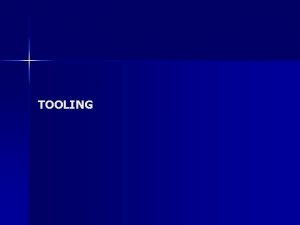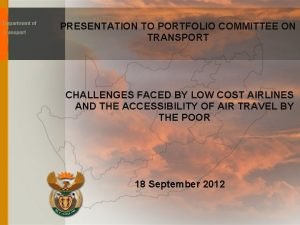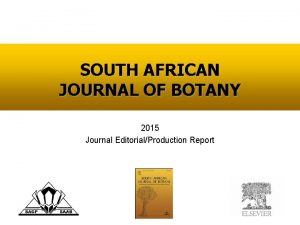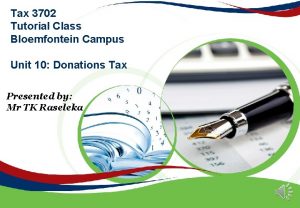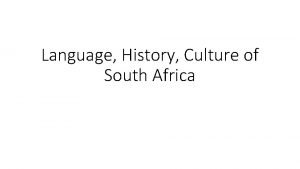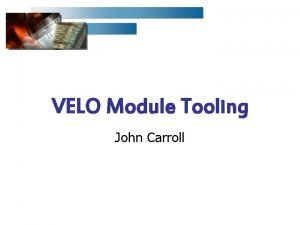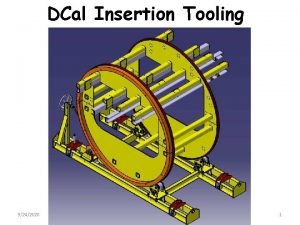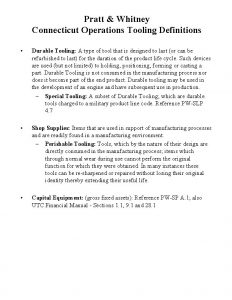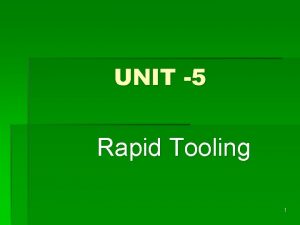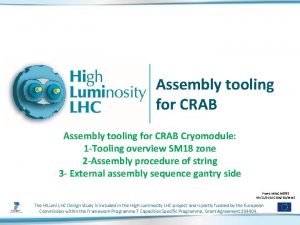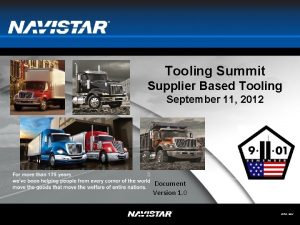KWAZULUNATAL TOOLING INITIATIVE Restructuring of the South African














- Slides: 14

KWAZULU-NATAL TOOLING INITIATIVE Re-structuring of the South African Tool, Die and Mould-making Industry Presented by: Umash Ramkalawon Regional Programme Manager KZNTI

KZNTI A Public-Private Partnership STRATEGIC DRIVER FUNDER KEY STAKEHOLDERS TOOLMAKING ASSOCIATION OF SOUTH AFRICA (TASA) DEPARTMENT OF ECONOMIC DEVELOPMENT & TOURISM TASA Support the needs of the TDM Industry Aligned to the sector development projects of the DEDT aligned to the IPAP (DEDT) DEDT TIKZN e. Thekwini Municipality mer. SETA Department of Education Multi-stakeholder support Rehabilitation and growing of the Tool, Die & Mould-making Industry in South Africa

History of the TDM Sector in SA % Annual turnover Capacity Sector ratio (increasing imports from China and others) 1% Mining & other Automotive(7 OEMs) BMW 25% Toyota 40% 80% Nissan Volkswagen 35% 4, 6% EU General Motors Mercedes Benz Packaging &consumer goods Global Loss In Local Tooling Manufacturing Capacity SA Ford Motor company 1990 2010

Distress Drivers for the Sector in SA Skills Erosion & Job losses Technology Stagnation Loss of Capacity Loss of Competitiveness BBBEE Growing trade deficit • Critical shortage of Designers, Artisans, Engineers • and Project Managers in the sector. • Radical changes in Skills Value Chain. • Lack of recapitalization • Lack of focused R&D. • Industry demand growing, Enterprise quantity declining • China, India, EU increased pressure • Absence of BBBEE transformation in TDM industry • Increasing imports – decreasing exports

Economic Impact of the Tooling Sector in SA • The tooling sector can be classified as a sub-sector under the “Metal Fabrication, capital equipment and transport equipment” sector • High employment and growth multipliers • Strong backward linkages

National Intervention in the TDM Sector • The Tooling Initiatives across SA is guided by the intervention programmes set by the National Tooling Initiative(NTI) which has been incorporated into the DTI’s Industrial Policy Action Plan – IPAP(20132016) as a key action programme for Capital Equipment and Allied Services. Establishment of TDM Cluster Management structures in 6 provincial locations

KZNTI Strategic Concept GOVT POLICY SKILLS MARKET DEVELOPMENT SUSTAINABLE ECONOMIC GROWTH within the TDM SECTOR

KZNTI Intervention Projects TDM sector skills development Business capacity expansion Technology recapitalization Competitiveness improvement Cluster structure development Localisation of international tooling companies

TDM Sector Skills Development • TDM Powered Apprenticeship Programme • • Pilot programme developed by industry experts and funded by the DTI The future tooling qualification Ø Ø Ø 526 students at selected FET Colleges across the country 65 students in KZN • Level 1 20 students in Pmb • Level 2 19 Students in Pmb 26 Students in Dbn Additional intake of 500 students for 2014

…. continued

Business Capacity Expansion • Tooling Incentive Scheme • Recommended amendments to the current investment incentive structure of the Automotive Production and Development Programme (APDP) and the Automotive Investment Scheme(AIS) • AIS o Current capital investment incentive structure ranges from 20% to 30% o It is proposed that this incentive is offered to automotive tooling at a 50% standard rate • APDP o The light vehicle APDP offer's local value addition incentives in the form of a Production Incentive applied for via a Production Rebate Credit Certificate o It is proposed that for tooling local value addition, the benefits apply at the vulnerable products level to provide a significant boost to tooling localization.

…. continued Rand value of imported automotive tooling used for calculations are as follows, • • Historic average of R 2, 227 billion per annum Forecasted value of R 4 billion per annum Historic average (R 2 227 million) Forecast (R 4 000 million) R 534 000 R 960 000 Additional AIS for Local tooling (R 107 000) (R 192 000) Production incentive (R 75 000) (R 128 000) Benefit to SA economy R 353 000 R 640 000 66% 67% (R 25 000) ( R 38 000) Additional local value added Benefit as a % of VA Extra cost to Govt. for VP incentives per annum

Competitiveness Improvement • Business Development and Systems Training

THANK YOU
 Hard tooling vs soft tooling
Hard tooling vs soft tooling Safi south africa
Safi south africa North south initiative
North south initiative Hartswater bosluis
Hartswater bosluis South african tax
South african tax South african journal of botany impact factor 2020
South african journal of botany impact factor 2020 South african transport conference
South african transport conference South african tax
South african tax Akrikaans
Akrikaans National archives and records service
National archives and records service South african council for the architectural profession
South african council for the architectural profession Hamilton naki
Hamilton naki South african principals association
South african principals association South african council for natural scientific professions
South african council for natural scientific professions Apartheid
Apartheid
